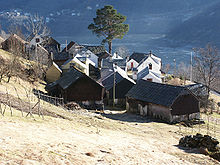Havrå

Havrå or Havre sometimes Havretunet or Havråtunet is a cluster of farm in Osterøy municipality in Hordaland, Norway. Havrå is one of the very last and best preserved of the common farm clusters on the Western coast of Norway. Havrå was the first cultural environment to be protected under section 20 of the Norwegian Cultural Heritage Act. It was not connected to road until late in the 1960s.
Havrå is situated in a very steep terrain on the south side of Osterøy and is shaped in line typical for steep terrain in the Norwegian fjords. It can be clearly seen from both the railway (Bergensbanen) and the highway between Bergen and Oslo.
Many of the buildings at Havrå are characteristic to the inner coastal district between Bergen and Sognefjorden; the combination of dry masonry and juniper cladding on barn facades exposed to rain and wind.

History of names
The name, with various spellings, dates back as far as 1303. In the oldest sources the name is written Havra (possibly representing Havrá). From the 16th century the name was often spelled (with many variations) Havre. [1]
In 1949-1950 a film about life at Havrå was made: Havretunet. It was released in 1952. Some of the people taking part in the takes of the film worked to change the name from Havre to Havrå. This changing of name was accepted by the National Map Service, but the name change remains controversial among the local population. [2][3]
Gallery
-
Havretunet between the houses
-
Havretunet between the houses
-
Weather exposed barn walls clad with juniper. Juniper keeps the lashing rain out, permits draft and keeps the hay dry.
-
A demanding technique, but the cladding lasts for 30-50 years
-
The grain is poured into the tract and the flavour is gathered on the desktop surrounding millstones and is wiped down to a bin in the front of the table
-
The mills are near the houses
-
Havretunet from across Sørfjord, near Romslo
References
See also
External links
- Template:No icon Stiftinga Havråtunet
- Template:No icon Introduction to the documentary film about Havretunet
- Havretunet at IMDb
- Havråtunet at IMDb Short version of the original documentary film Havretunet
- Kulturnett Hordaland
- Stiftinga Havråtunet
- Museumssenteret i Hordaland
- Miljøstatus i Norge: Havrå








